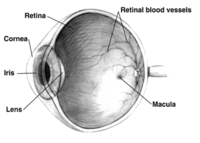
Photo from wikipedia
ABSTRACT Purpose To present a semi-automated method of image alignment to aid in monitoring the progression of inherited retinal degenerations (IRDs). Results A 22-year-old woman presented with nyctalopia and a… Click to show full abstract
ABSTRACT Purpose To present a semi-automated method of image alignment to aid in monitoring the progression of inherited retinal degenerations (IRDs). Results A 22-year-old woman presented with nyctalopia and a family history of retinitis pigmentosa (RP), but with no prior genetic testing. Fundus examination showed a sectoral retinal degeneration involving the inferior and nasal retina with rare, pigmented deposits. Goldmann kinetic perimetry demonstrated corresponding superotemporal visual field defects. The best-corrected visual acuity was 20/20 in both eyes. Multimodal imaging delineated geographically restricted peripheral retinal degeneration extending to the inferior edge of the macula. Central visual function remained intact with normal multifocal electroretinography findings. Optical coherence tomography (OCT) through the leading edge of the retinal degeneration confirmed loss of the photoreceptor layer and associated retinal pigment epithelium. In the region of retinal degeneration, loss of vascular flow density was noted on optical coherence tomography angiography (OCTA). Genetic testing identified a pathologic sequence variant in RHO (c.68C>A, p.Pro23His), confirming autosomal dominant sector retinitis pigmentosa (SRP). Image alignment allowed for precise measurement of the progression of SRP over a period of 18 months. Conclusion SRP is a rare subtype of RP characterized by focal, typically inferior and nasal, retinal degeneration of the peripheral retina. Although the onset and extent of peripheral retinal degeneration varies, compared with RP, SRP typically progresses more slowly to involve the macula. In this report, we highlight the utility of image registration and alignment to aid in monitoring disease progression in IRDs by means of multimodal imaging.
Journal Title: Ophthalmic Genetics
Year Published: 2022
Link to full text (if available)
Share on Social Media: Sign Up to like & get
recommendations!